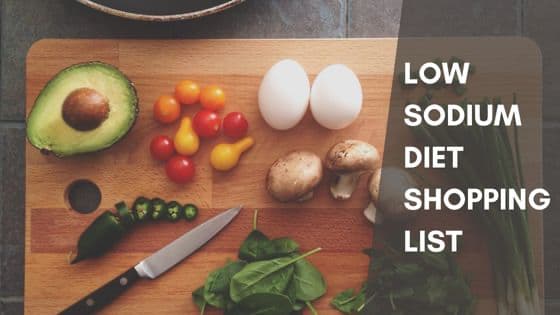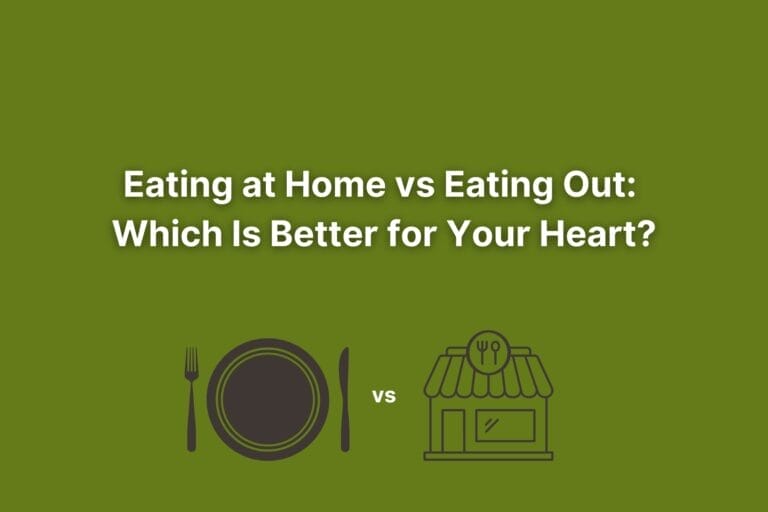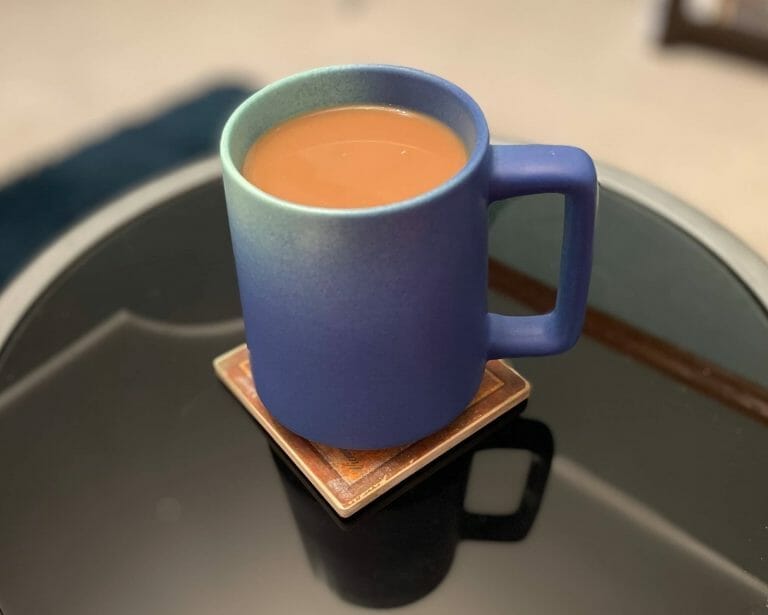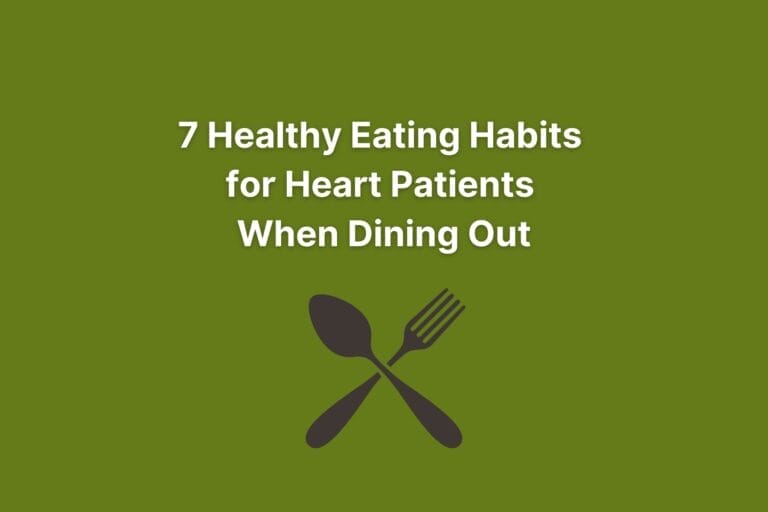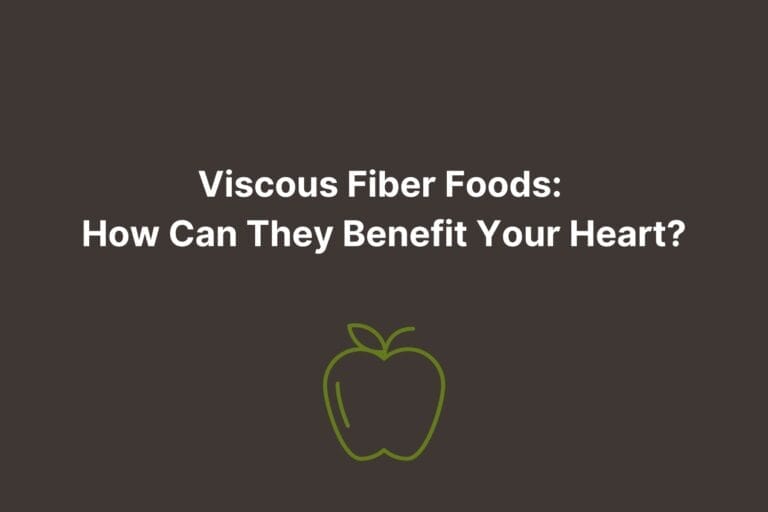The Low Sodium Diet Shopping List: Your Comprehensive Guide
This post may contain affiliate links, which means I’ll receive a commission if you purchase through my links, at no extra cost to you. Please read my full disclosure for more information.
If you’re reading this article right now, chances are you’ve been told to follow a low sodium diet, or maybe you’re looking into trying to make some changes in what you eat. One way or the other, you’ve come to the right place. Choosing the options in this low sodium diet shopping list may help you meet your health goals.
Quick disclaimer—although I am a registered dietitian nutritionist, your reading of this or any articles on this website does not constitute medical nutrition therapy advice nor create a practitioner-client relationship. The information I provide here on this website is for educational and informational purposes only. Please see my full disclaimer for more information.
Why Follow a Low Sodium Diet?
Maybe you have high blood pressure, or maybe you’ve been diagnosed with heart failure and told to follow a low sodium diet. Choosing lower sodium food options can help in several ways.
First, a low sodium diet can help improve blood pressure.1 For some people, this is the difference between needing to start a blood pressure medication and avoiding the need for medication altogether.
Second, a low sodium diet can help prevent fluid retention, the buildup of too much water in your body. Of note, for people with heart failure, avoiding foods high in sodium can be helpful in preventing fluid retention. This may help you avoid being stuck in the hospital if you are holding onto too much fluid.
Third, foods low in sodium are also usually better for you. Foods higher in sodium, such as restaurant foods, may also contain some not as healthy fats as well as sugar. These foods are often higher in calories, which may contribute to unwanted weight gain.
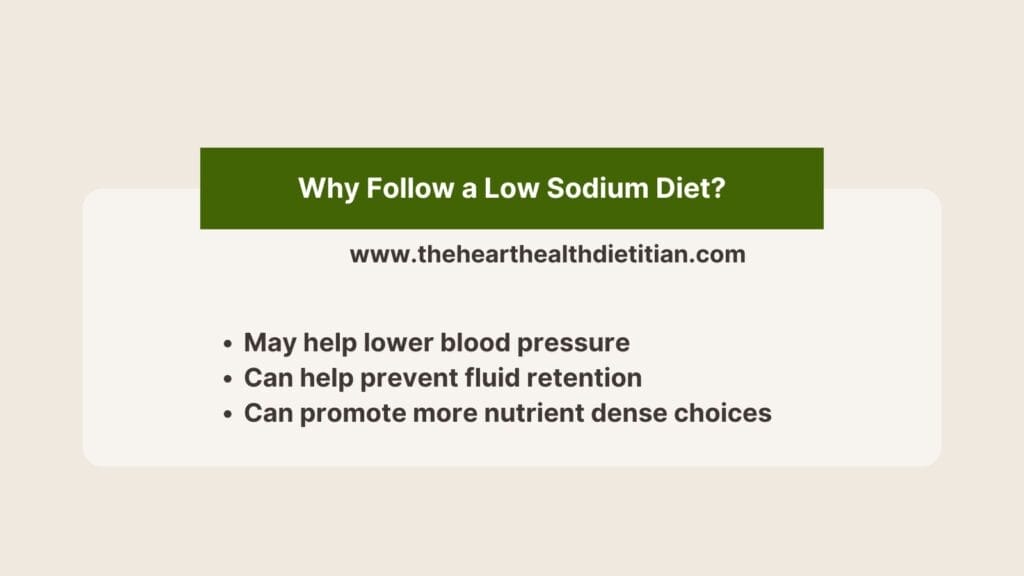
What Foods Should Be Included in a Low Sodium Diet Shopping List?
Now that we’ve seen why following a low sodium diet may be helpful to you, let’s move on to what foods to add to your low sodium diet shopping list.
An important fact to remember is that most foods don’t have to be off limits. Instead, there are usually lower sodium or no salt options of a lot of the foods you may already eat. Finding these foods may help this eating plan feel less overwhelming for you.
Fruits
Let’s start with fruits. Each fruit has its own special nutritional benefits. For most people, it’s okay to eat most fruits. If your doctor or dietitian has told you to avoid certain fruits, then do follow their instructions.
The following types of fruits can be a part of a low sodium diet:
- Fresh fruits—you can buy pre-cut fruits to save time.
- Frozen fruits—buy ones without any added sugars.
- Canned fruits—buy them in water or in natural juices.
- Dried fruits—choose ones without any added sugars.
If possible, try to avoid fruits that come in heavy syrups or with other flavorings or extra sugar.
Vegetables
Moving on to vegetables, the same suggestion applies—if your doctor or dietitian has told you to avoid or cut back on any certain vegetables, follow their recommendations.
Otherwise, the following types of vegetables can be part of a low sodium diet:
- Fresh vegetables—like with fruits, you can buy pre-cut to save time.
- Frozen vegetables—avoid added sauces or seasonings.
- Canned vegetables—choose low sodium, reduced sodium, or no added salt varieties.
- Vegetable juice—aim for low sodium options.
As with choosing fruits, try to avoid extra sauces, seasonings, creamy preparations, etc.
Grains
Now let’s talk about grains. As mentioned for fruits and vegetables, do follow your doctor’s or dietitian’s instructions about avoiding any certain types of grains if that’s something that is important for your health.
- Pasta—aim for the plain varieties, with no extra seasonings or flavorings added.
- Rice—try the plain kinds, with no flavorings or seasonings added.
- Other grains such as quinoa, bulgur, and barley—aim for the plain kind and add your own seasonings later.
- Breads, bagels, rolls, and similar items—choose lower sodium versions.
- Popcorn, pretzels, chips, and other snacks—choose low sodium or unsalted versions.
You can always add your own lower sodium or salt free seasonings after cooking these grains. Many recipes are available online to give you some ideas.
Legumes
Legumes are maybe a less talked about type of food. This category is mostly a fancy name for beans, although peanuts are technically considered legumes!
- Dried beans—these are great options; you can cook them and add your own seasonings later.
- Canned beans—choose low sodium or reduced sodium versions; if available, try no salt added options.
- Hummus—compare brands to find the ones that are lower in sodium.
- Peanuts—aim for raw and unsalted or very lightly salted; more ideas will be in another section of this article.
Although legumes may not be as talked about as other foods, there are still many options you can try. Get creative by finding new recipes to try online.
Dairy
Another food group to consider is dairy. A few suggestions are below.
- Yogurt—choose low fat or reduced fat as you’re able to.
- Milk—choose low fat or reduced fat if possible.
- Cottage cheese—aim for no salt added or reduced sodium types if they’re available.
- Other cheeses—some lower sodium types include fresh mozzarella, mascarpone, ricotta, and Swiss cheeses.
- Butter—choose unsalted.
- Half and half—choose the plain option and try to avoid the flavored varieties.
Ice cream and other dairy-based dessert options may be okay, but try to eat them less often.
Meat, Fish, and Poultry
In this section, we’ll cover several types of protein sources. Even though they are different, the recommendations are basically the same for each type of protein.
- Eggs—aim for plain eggs you can make yourself, and try to avoid prepackaged egg dishes with extra seasonings.
- Ground beef—aim for plain, fresh ground beef without extra seasonings.
- Other cuts of beef—aim for fresh cuts without added marinades or seasonings.
- Ground pork—try to avoid any added seasonings/flavorings.
- Pork—choose fresh pork without marinades or seasonings, and try to avoid sausage and bacon.
- Ground turkey and ground chicken—avoid those with extra seasonings.
- Fresh turkey and chicken—avoid those injected with a saline (salt water) solution.
- Fish—choose fresh fish without seasonings and marinades.
- Canned fish—choose lower sodium varieties.
- Lunch meats—choose lower sodium options or try to avoid as you’re able.
If you do really enjoy bacon and sausage, try to find lower sodium options if possible. A suggestion would be to eat bacon and sausage as little as possible. Save them for special treats or special occasions.
Healthy Fat Sources
This category may combine foods from a few different food groups, but it’s worth mentioning as a category of its own. Healthy fat sources can help to round out a meal.
- Avocados—choose plain instead of prepackaged guacamole or avocado dips.
- Plant oils—some good oils to choose include olive, canola, avocado, and peanut oils.
- Nuts and seeds—choose unsalted options or very lightly salted.
- Nut and seed butters—choose unsalted or lower sodium versions.
Most of these foods also pair well with fruits and vegetables to make a balanced snack!
Condiments
These foods are ones you can use to add flavor to your meals. The spice aisle of your local grocery store will likely have most of these items.
- Herbs and spices—fresh or dried are great options.
- Vinegar—balsamic vinegar is a great flavoring option; you can also use other types of vinegar for different flavor goals.
- Garlic and onion powders—these are different from garlic salt and onion salt; powders do not contain salt.
- Lemon pepper seasoning—check the ingredients list to make sure this item is salt free.
Companies are now making more lower sodium or salt free condiments that you may see in your local grocery store. If you find something interesting, check the label to see if it’s salt free or has a low sodium amount per serving (under 140 milligrams if possible).
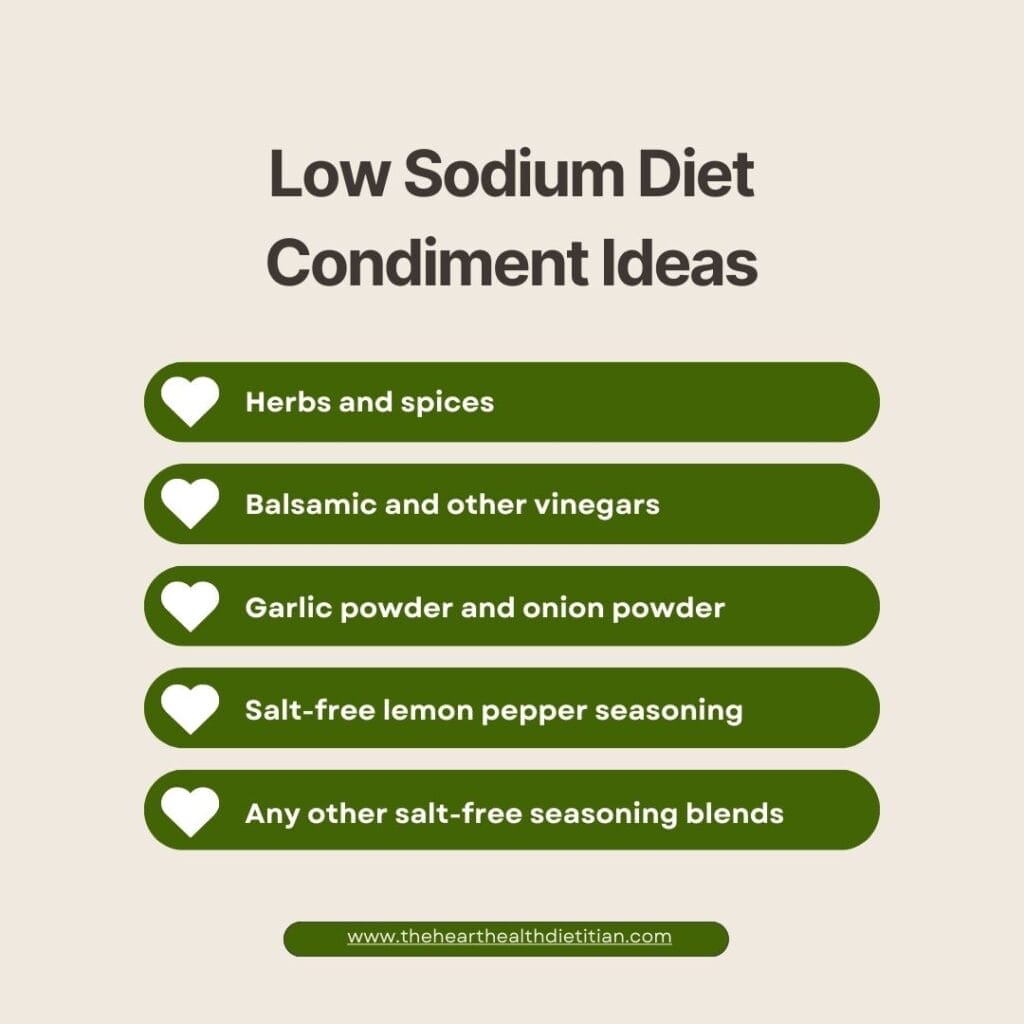
Beverages
Lots of beverages are considered low sodium. The list below will give you a few suggestions to try out.
- Coffee—plain; try to avoid coffee drinks with extra flavorings.
- Tea—try black tea, white tea, green tea, and herbal tea in loose leaf varieties, tea bags, or already brewed unsweetened teas.
- Sparkling waters—avoid tonic water and any other sugar sweetened types.
- Plant milks—many of these are fairly low in sodium.
- Juices—aim for 100% juice and use less often than the other choices mentioned above.
- Sodas—diet sodas contain less sugar than regular sodas, but you may wish to use any type of soda sparingly.
As you can see, there are plenty of low sodium beverage options. If you plan to consume alcohol, talk to your doctor and dietitian about what is a safe type and amount for you.

A Few Other Tips
This low sodium diet shopping list may sound overwhelming, but there are some things you can do to make this adjustment easier.
First, realize that adjusting to a low sodium diet will take some time. Try not to give up if it feels too hard. Focus on what you know you can change, and start with that.
Second, talk to your doctor or dietitian if you feel you need some extra support. They can help guide you to a plan that’s right for you.
Third, know that you can have some higher sodium foods once in a while. The key is to balance out what you eat during the rest of the day. Talk to your doctor or dietitian for suggestions on how to do that.
Conclusion
In conclusion, we’ve covered suggestions for foods to include in your low sodium diet shopping list. Hopefully now you have some ideas to get you started and to make your shopping trip less intimidating.
Now that you have the information, feel free to get started with these tips right away!
And if you enjoyed this blog post and haven’t yet signed up for email notifications when new blog posts are available, feel free to sign up. Thanks for reading!
Sources
- Filippini T, Malavolti M, Whelton PK, Naska A, Orsini N, Vinceti M. Blood pressure effects of sodium reduction. Circulation. 2021;143(16):1542-1567. doi: 10.1161/CIRCULATIONAHA.120.050371.
About the Author

